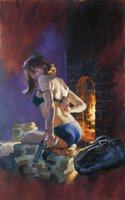 made Entertainment Weekly’s “Must List 2006” and today gets a major write-up in the Los Angeles Times.
made Entertainment Weekly’s “Must List 2006” and today gets a major write-up in the Los Angeles Times.Journalist-novelist Denise Hamilton (Prisoner of Memory) penned the Times article, which is chock-full of background on how Hard Case co-founder Charles Ardai got into this business (it seems he sold a profitable Internet company, Juno Online Services Inc., and used the funds as start-up capital), the delight contemporary authors have found in producing stories that carry a pulpish edge, and the success Hard Case has had in attracting critical attention (Domenic Stansberry’s The Confession [2004] won an Edgar Award, Max Phillips’ Fade to Blonde [2004] picked up a Shamus Award, and Stephen King’s The Colorado Kid [2005] found a place on the New York Times bestseller list).
Much of Hamilton’s piece, though, is devoted to the trashy-alluring, 1940s-’50s retro-pulp-style cover art that graces Hard Case paperbacks. As the Times explains, “To capture the retro feel they craved, Ardai and [the company’s co-founder, former Juno art director Max] Phillips
 tracked down artists such as Robert McGinnis, who drew some of the genre’s Golden Age covers, and hired them to paint some new Hard Case jackets.”
tracked down artists such as Robert McGinnis, who drew some of the genre’s Golden Age covers, and hired them to paint some new Hard Case jackets.”No doubt about it: In a time when publishers seem content to offer unimaginative or copycat covers, the presentation of Hard Case titles is helped immensely by their eye-catching art featuring lovely ladies both scantily attired and dangerous looking. One of my favorite covers hasn’t yet appeared, but was included in a recent newsletter e-mailed out by Hard Case. The illustration at right is by artist Greg Manchess and will front a reprint of The Vengeful Virgin, the late Gil Brewer’s 1958 novel, which is set to be resurrected by Hard Case next March. (Click on the illustration to enlarge it.)
Hamilton concludes her story by quoting Robert McGinnis, who was once in great demand by book publishers, saying how pleased he is to be doing work again in the field.
Sheesh. It’s hard to believe, and sad, that America under George W. Bush might be more prudish than it was under Dwight Eisenhower.But the artist, known for his sultry female portraits, was surprised when Hard Case asked him to add a few clothes to the cover he did for “Little Girl Lost,” which initially featured a woman who was naked except for a wispy lace garment on one arm.”
It’s ironic,” said Ardai. “You could show a completely naked woman on a paperback cover in the 1950s, as long as she was facing away from the viewers, but today, covers that risqué wouldn’t fly with at least some retailers.”
(Hat tip to Anthony Rainone’s Criminal Thoughts.)
LEARN MORE: “Stephen King and Artist Robert McGinnis,” by Caveat Lector (The Word Demon).

















2 comments:
Hard Case's early critical attention, you should add, included an Edgar nomination for Little Girl Lost by Richard Aleas. Aleas being an alias for Charles Ardai himself.
Laurie King
I'm probably being too picky, but when Hamilton refers to the paperback originals of the 1950s as "dime novels," it really grates on me.
Post a Comment